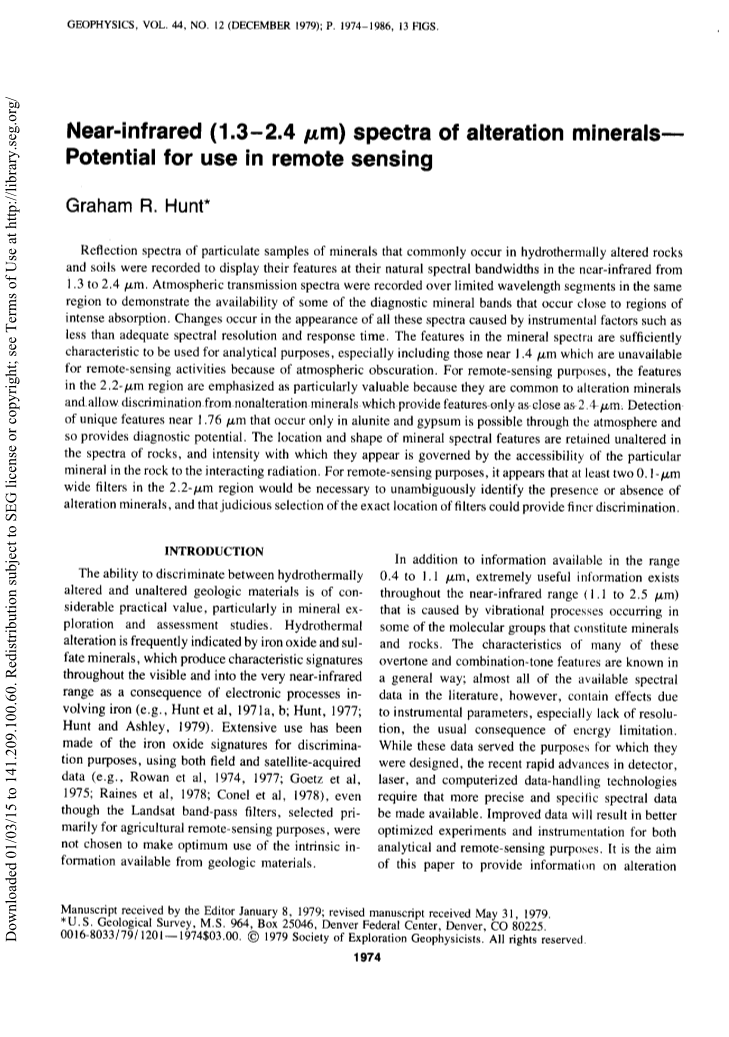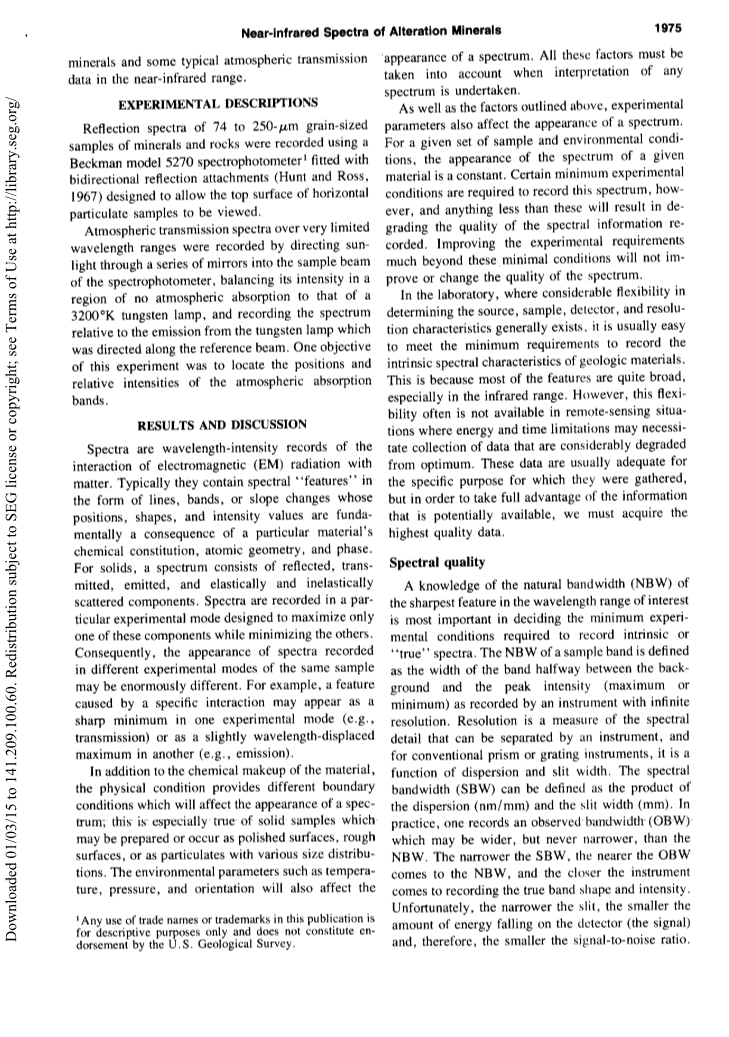基于遥感的岩矿光谱特征及信息提取研究外文翻译资料
2022-12-29 11:49:03
本科毕业设计(论文)
外文翻译
Near-infrared (1.3-2.4 ) spectra of alteration minerals- Potential for use in remote sensing
作者: Graham R. Hunt*
国籍:America
出处:GEOPHYSICS
Reflection spectra of particulate samples of minerals that commonly occur in hydrothermally altered rocks nd soils were recorded to display their features at their natural spectral bandwidths in the near-infrared from1.3 to 2.4 pm. Atmospheric transmission spectra were recorded over limited wavelength segments in the same
region to demonstrate the availability of some of the diagnostic mineral bands that occur close to regions of intense absorption. Changes occur in the appearance of all these spectra caused by instrumental factors such as less than adequate spectral resolution and response time The features in the mineral spectra are sufficiently characteristic to be used for analytical purposes, especially including those near I .4 pm which are unavailable for remote-sensing activities because of atmospheric obscuration. For remote-sensing purposes, the features in the 2.2-km region are emphasized as particularly valuable because they are common to alteration minerals
and allow discrimination from nonalteration minerals which provide features-only as-close as?.-Cpm. Detection of unique features near 1.76 pm that occur only in alunite and gypsum is possible through the atmosphere and so provides diagnostic potential. The location and shape of mineral spectral features are retained unaltered in the spectra of rocks, and intensity with which they appear is governed by the accessibility of the particular mineral in the rock to the interacting radiation. For remote-sensing purposes, it appears that at least two 0. I-pm wide filters in the 2.2-pm region would be necessary to unambiguously identify the presence or absence of alteration minerals, and that judicious selection of the exact location of filters could provide finer discrimination.
INTRODUCTION
The ability to discriminate between hydrothermally altered and unaltered geologic materials is of considerable practical value, particularly in mineral exploration and assessment studies. Hydrothermal alteration is frequently indicated by iron oxide and sulfate minerals, which produce characteristic signatures throughout the visible and into the very near-infrared range as a consequence of electronic processes involving iron (e.g., Hunt et al, 197la, b; Hunt, 1977; Hunt and Ashley, 1979). Extensive use has been made of the iron oxide signatures for discrimination purposes, using both field and satellite-acquired data (e.g., Rowan et al, 1974, 1977; Goetz et al, 1975; Raines et al, 1978; Cone] et al, 1978), even
though the Landsat band-pass filters, selected primarily for agricultural remote-sensing purposes, were not chosen to make optimum use of the intrinsic in-
formation available from geologic materials.
In addition to information available in the range 0.4 to I. 1 pm, extremely useful information exists throughout the near-infrared range ( I. 1 to 2.5 pm) that is caused by vibrational processes occurring in some of the molecular groups that constitute minerals and rocks. The characteristics of many of these
overtone and combination-tone features are known in a general way; almost all of the available spectral data in the literature, however, contain effects due
to instrumental parameters, especially lack of resolution, the usual consequence of energy limitation. While these data served the purposes for which they were designed, the recent rapid advances in detector, laser, and computerized data-handling technologies require that more precise and specific spectral data be made available. Improved data will result in better optimized experiments and instrumentation for both analytical and remote-sensing purposes. It is the aim of this paper to provide information on alteration minerals and some typical atmospheric transmission data in the near-infrared range.
EXPERIMENTAL DESCRIPTIONS
Reflection spectra of 74 to 250-pm grain-sized samples of minerals and rocks were recorded using a Beckman model 5270 spectrophotometerrsquo; fitted with bidirectional reflection attachments (Hunt and ROSS, 1967) designed to allow the top surface of horizontal particulate samples to be viewed. Atmospheric transmission spectra over very limited wavelength ranges were recorded by directing sun hight through a series of mirrors into the sample beam of the spectrophotometer, balancing its intensity in a region of no atmospheric absorption to that of a 3200°K tungsten lamp, and recording the spectrum relative to the emission from the tungsten lamp which was directed along the reference beam. One objective of this experiment was to locate the positions and relative intensities of the atmospheric absorption bands.
RESULTS AND DISCUSSION
Spectra are wavelength-intensity records of the interaction of electromagnetic (EM) radiation with matter. Typically they contain spectral “features” in the form of lines, bands, or slope changes whose positions, shapes, and intensity values are fundamentally a cons
剩余内容已隐藏,支付完成后下载完整资料


英语原文共 13 页,剩余内容已隐藏,支付完成后下载完整资料
资料编号:[276471],资料为PDF文档或Word文档,PDF文档可免费转换为Word




